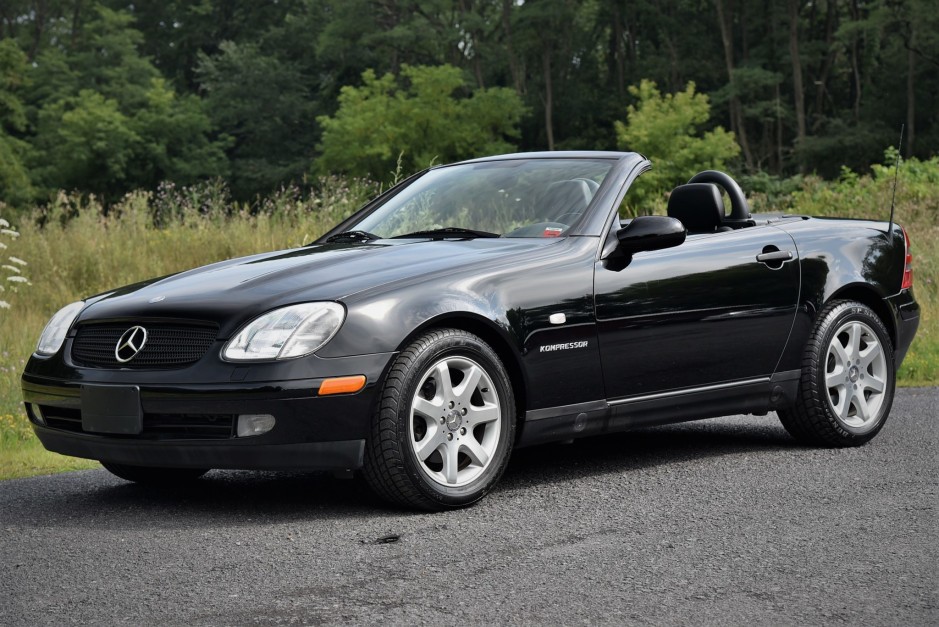The Mercedes-Benz SLK 230 Roadster emerged in the late 1990s as Mercedes’ answer to a growing demand for smaller, more accessible luxury sports cars. Designed to attract a younger demographic, the SLK 230 offered a compelling blend of Mercedes engineering, stylish design, and open-top driving pleasure, all in a more compact and affordable package than its larger SL sibling. This review delves into the key aspects of the SLK 230, exploring what made it a desirable roadster then and now.
Chic Design and Sporty Aesthetics
From its launch, the SLK 230 made a visual statement. Its wedge-shaped profile, long hood, and short deck evoked classic roadster proportions while maintaining a distinctly modern Mercedes flair. The optional Sport Package further enhanced its athletic stance, featuring larger 17-inch wheels and subtle aerodynamic enhancements that contributed to a more muscular and assertive appearance. The design ensured that the SLK 230 looked appealing from every angle, projecting a sense of sporty elegance.
 The Mercedes SLK 230 Roadster, a compact and sporty convertible from Mercedes-Benz.
The Mercedes SLK 230 Roadster, a compact and sporty convertible from Mercedes-Benz.
Interior and Unique Features
Inside, the SLK 230 embraced a “chic-retro” aesthetic, characterized by white gauges with black markings that provided a distinctive and easily readable instrument panel. While designed to be more accessible, the SLK 230 still offered a respectable level of features, surpassing many of its competitors in standard equipment. However, the standout feature of the SLK 230 was undoubtedly its retractable hardtop. With the simple push of a button, the roof elegantly folded and disappeared into the trunk in around 30 seconds. This innovative feature provided the security and refinement of a coupe with the open-air freedom of a convertible, making it a true head-turner and a practical choice for diverse driving conditions. Beyond the hardtop, safety was a priority, with a reinforced windshield frame, roll bars behind the seats, side airbags, and anti-slip control all included as standard.
Performance and Driving Dynamics
Under the hood, the SLK 230 was powered by a supercharged 2.3-liter four-cylinder engine, denoted by the Kompressor badge. This engine delivered 185 horsepower, providing brisk acceleration and ample power for spirited driving. While it might not have possessed the outright punch of larger six-cylinder engines found in rivals like the BMW Z3 2.8 or Porsche Boxster, the supercharged four-cylinder offered a unique and engaging driving experience. The ride was firm, as expected from a sports roadster, but the handling was praised as outstanding, offering precise and responsive cornering. Furthermore, the SLK 230 impressed with its minimal wind buffeting when driving with the top down, enhancing the open-air experience.
Practicality and Cargo Space
Despite its compact dimensions, the SLK 230 offered surprising practicality. The trunk, although listed at a modest 3.7 cubic feet, was noted to be cleverly shaped, allowing it to accommodate more luggage than the numbers might suggest. This was highlighted by anecdotes of owners successfully using the SLK 230 for camping trips, demonstrating that the usable space was well-designed. Even with the retractable hardtop stored in the trunk, some space remained for smaller items.
Conclusion: A Desirable Roadster
The Mercedes Slk 230 Roadster quickly became a sought-after vehicle, and for good reason. It successfully combined Mercedes-Benz luxury and engineering with a sporty roadster experience in a more accessible package. Its striking design, innovative retractable hardtop, and engaging performance made it a compelling choice for buyers seeking open-top driving pleasure with a touch of German engineering. While it entered a competitive market, the SLK 230 carved out its own niche and remains a fondly remembered and desirable roadster today.
Specifications (as tested in 1998):
- Type: Two-Door Roadster
- Engine: Supercharged 185-horsepower, 2.3-liter inline four
- Transmission: Five-speed manual
- EPA Mileage: 21 city/30 highway
- Tested Price: $45,980